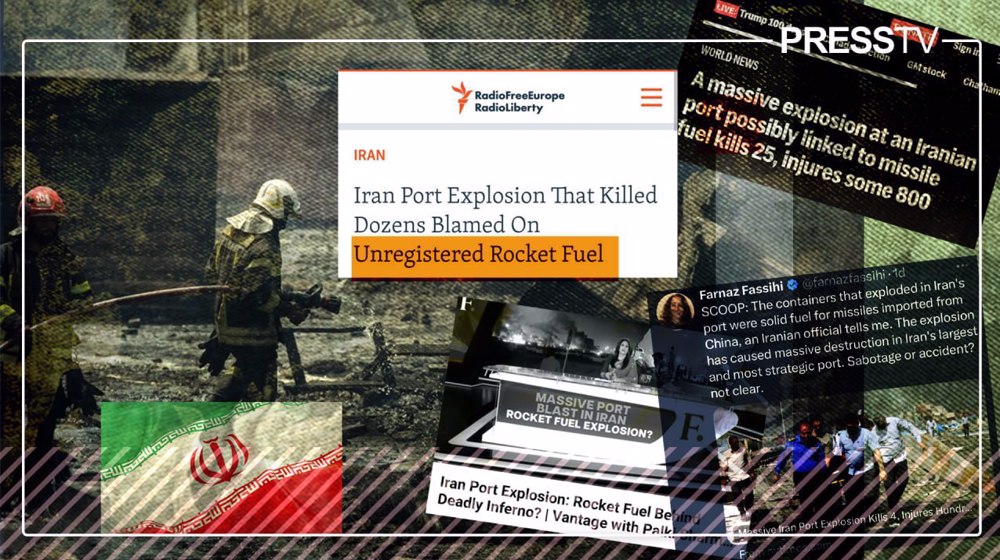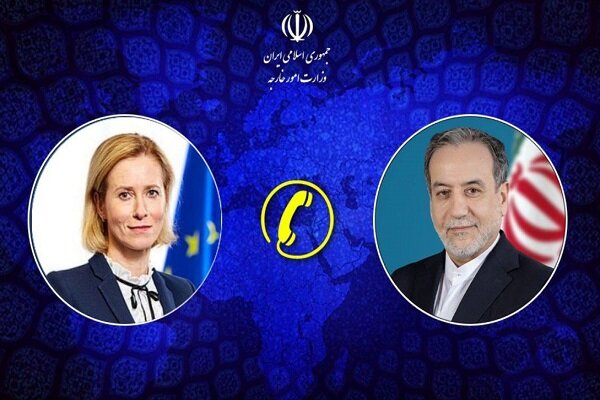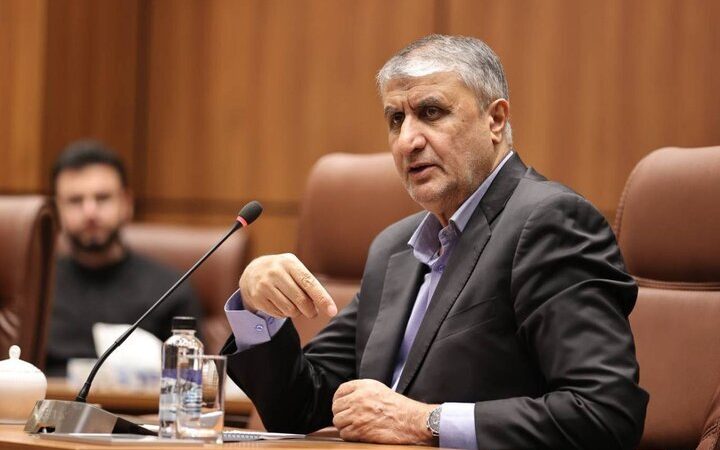How Western media again jumped on propaganda bandwagon over Iran port explosion

By Ivan Kesic
The tragic accident that claimed dozens of lives at the Shahid Rajaee Port near Bandar Abbas in southern Iran last month has been exploited by Iran’s enemies for politically motivated, malicious activities and attempts to falsify the true cause of the explosion.
On April 26, a powerful explosion at the Shahid Rajaee Port in southern Iran resulted in widespread damage and casualties, leaving at least 70 dead and over 1,000 injured.
The true cause of the explosion remains shrouded in mystery, with multiple investigations underway. According to Iranian officials, it is most likely linked to the handling of highly flammable cargo.
While the country’s emergency officials managed to contain the fire and provide medical treatment to the injured, anti-Iran propagandists in the West were quick to disseminate misinformation about the cause of the explosion in yet another attempt to incite mass unrest.
Disseminating disinformation
As part of their disinformation campaign, Western media outlets have falsely claimed that the cause of the explosion was a military cargo, more specifically, “rocket fuel that Iran had shipped from China.”
This false claim was largely sensationalized in headlines, while the body of the text referred to it as a rumor, using terms such as “possibly,” “purportedly,” or “allegedly” in relation to the rocket fuel.
Most of these propaganda outlets relied on a British military firm that has recently become a primary source of information on maritime events in the Indian Ocean, adhering to the official Anglo-American narrative, and citing anonymous and bogus sources.
Ambrey claimed that “the fire was reportedly the result of improper handling of a shipment of solid fuel intended for use in Iranian ballistic missiles,” as quoted by Western media.
Although unnamed in many articles, this false claim indirectly implicated the Islamic Revolution Guards Corps (IRGC), which is responsible for the development and operation of Iran’s missile program.
This disinformation builds upon two earlier narratives, both of which were released in the past six months and align with Anglo-American anti-Iranian, anti-Chinese, and pro-Israel policies.
The first involved claims that two Iranian ships arrived from China in Bandar Abbas in February and March, carrying 1,000 tons of sodium perchlorate and ammonium perchlorate, respectively.
There has been no confirmation of these claims from Iranian, Chinese, or independent sources, nor any evidence to substantiate them. Nevertheless, Western media outlets have continued to spread this false information in recent months.
To support these fabrications, these outlets often manipulatively referenced maritime websites that track ship movements, but do not provide any details regarding cargo.
The second, even older disinformation centers on an alleged “successful Israeli attack” in October 2024, which supposedly destroyed Iran’s rocket fuel mixing facilities. This narrative has recently been cited as the reason for the Iranian shipment from China.
An even more bizarre version of this story claims that Iranian missile stockpiles were left “depleted” after launching ballistic missiles at the Zionist regime last year.

Baselessness of claims
Brigadier General Reza Talaei-Nik, a spokesperson for Iran’s Defense Ministry, denied claims that missile fuel had been imported through the port before the explosion took place.
In an interview with local media, he stated that there were no military-related export or import cargoes at Shahid Rajaee Port, dismissing the unsubstantiated claims as “targeted disinformation and propaganda spread by foreign media.”
Talaei-Nik added that this propaganda is part of the psychological operations carried out by Iran’s enemies, which have been attempted in the past but consistently thwarted by the Iranian nation.
Other Iranian officials have emphasized to local media that Iran is self-sufficient in the production of ballistic missiles and has no need to import any foreign components.
It was also pointed out that transporting military cargo in commercial containers does not align with established protection and security protocols. If Iran needed to transport military cargo, it would use non-commercial ports.
The notion of military containers sitting idle in a customs yard, awaiting administrative formalities, was described as completely illogical. An entity capable of importing such cargo would, logically and routinely, transfer it immediately to military bases, according to experts.
Even Western reports, despite their sensationalist headlines and claims, state that “it was unclear why Iran wouldn’t have moved the chemicals from the port” all this time, considering that, according to their claims, the second ship from China had arrived a month earlier, on March 26.
Thirty-year-old Western analyses also confirm that by the end of the last century, Iran had mastered the production of perchlorate, a key ingredient in the manufacture of solid rocket propellant, further refuting claims about the need for imports.
The very idea that Iran would supposedly base its entire missile power on the import of foreign fuel, using sea routes where an enemy could easily intercept Iranian merchant ships, also seems highly implausible.
The motives for the disputed imports are also based on flimsy grounds, beginning with the claim that Iran is short of rocket fuel due to retaliatory attacks on the Zionist regime last year.
Visual evidence indicates that Iran fired a total of 53 missiles in three salvos during Operation True Promise 2, a negligible fraction (
The second unfounded motive is based on exaggerated claims that an Israeli strike in October 2024 destroyed or significantly damaged alleged solid rocket fuel processing facilities at Parchin and Khojir, although available evidence suggests otherwise.
The Israeli regime claimed to target these facilities with low-flying cruise missiles or drones with relatively weak warheads compared to Iran’s ballistic warheads, which would be incapable of destroying or damaging well-protected underground facilities.
If there had been true destruction or damage to the rocket fuel mixing facility, large explosions would have occurred due to the stored explosive material, yet no such explosions are visible in the available satellite imagery following the attack.

Based on the presence of dark orange smoke during the fire in Bandar Abbas, military experts ruled out the possibility of burning ammonium perchlorate or sodium perchlorate, as they burn in light blue and light yellow colors, respectively.
The main suspicion falls on ammonium nitrate, a common agricultural fertilizer responsible for dozens of deadly industrial accidents around the world, which has no military application.
Who spreads fake news and why?
Disinformation regarding the alleged rocket fuel as the cause of the explosion surfaced the same evening, just a few hours after the incident. The two main sources of this information were the American media outlets, the Associated Press (AP) and the New York Times (NYT).
The AP cited the murky British firm Ambrey, often referred to as a “maritime security and risk management company,” as a source for the so-called rocket fuel.
However, Ambrey is actually a private mercenary firm, operating in the same sector as notorious companies like Blackwater (now Academi). It provides military support to commercial ships transiting through the Bab-el-Mandeb Strait.
Observers suggest that firms like Ambrey operate with approval from Western navies, raising concerns about the privatization of naval security and diminished government accountability.
Similar to the highly controversial Syrian Observatory for Human Rights (SOHR), Ambrey has become an indispensable reference in Western media for any Yemeni retaliatory attacks on Israeli-linked ships in the Red Sea and the Gulf of Aden.
However, it is quite clear that the detailed information actually originates from Anglo-American military intelligence services, with Ambrey serving only as a front for the media.
From this, it can be concluded that the disinformation is coming from London and Washington, who are attempting to smear the IRGC, their arch-rival in West Asia.

The NYT article has the byline of Farnaz Fassihi, an American journalist of Iranian origin, and Aaron Boxerman, an Israeli reporter based in occupied Jerusalem al-Quds.
On platform X (formerly Twitter), Fassihi claimed that she received (mis)information about imported rocket fuel from China from “an Iranian official” who wished to remain anonymous.
Both Fassihi and the NYT have long been known for their fierce anti-Iranian positions, aligned with official American foreign policy. The latter gained notoriety in the 1980s when it spread disinformation about the Imposed War.
Furthermore, referring to fictitious “anonymous sources” is a favored tactic of anti-Iranian propagandists who have been attempting to pin responsibility for various accidents on the government, state services, or the military for years.
Whether it was a dead cheetah cub, a collapsed girl in the subway, a flood, an earthquake, or a meteor strike, they always find “anonymous witnesses” or some similar trace of official Tehran.
The bot farms of the Israeli regime and the Mujahedin-e-Khalq Organization (MKO) terrorist cult also joined the smear campaign, and according to preliminary statistics, they published 20,000 posts with disinformation and fake news on social networks in the days following the accident.
In a human tragedy with dozens of victims, they recognized yet another opportunity to exploit the event for vile manipulation and hateful accusations, hoping to provoke mass dissatisfaction, riots, and ultimately, their unfulfilled dream—the toppling of the Iranian political system.






